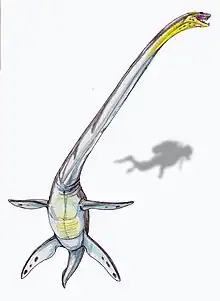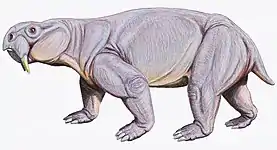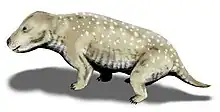| |||
|---|---|---|---|
| +... |
Paleontology or palaeontology is the study of prehistoric life forms on Earth through the examination of plant and animal fossils.[1] This includes the study of body fossils, tracks (ichnites), burrows, cast-off parts, fossilised feces (coprolites), palynomorphs and chemical residues. Because humans have encountered fossils for millennia, paleontology has a long history both before and after becoming formalized as a science. This article records significant discoveries and events related to paleontology that occurred or were published in the year 1943.
Dinosaurs
Newly named dinosaurs
Data are courtesy of George Olshevky's dinosaur genera list.[2]
| Name | Status | Authors | Location | Notes | Images | |
|---|---|---|---|---|---|---|
| Pachycephalosaurus[3] | Valid taxon |
|
|
A large pachycephalosaurid | ||
Plesiosaurs
New taxa
|
| |||||||||||||||||||||||||||||||||||||||||||||||||||||||||
Synapsids
Non-mammalian
| Name | Status | Authors | Age | Location | Notes | Images |
|---|---|---|---|---|---|---|
|
Valid |
Romer | 237 millions of years ago | The Dicinodont with terrible teeth. | |||
|
Valid |
Cabrera | 226 millions of years ago | This was a plant-eating Cynodont. | |||
|
Valid |
||||||
References
- ↑ Gini-Newman, Garfield; Graham, Elizabeth (2001). Echoes from the past: world history to the 16th century. Toronto: McGraw-Hill Ryerson Ltd. ISBN 9780070887398. OCLC 46769716.
- ↑ Olshevsky, George. "Dinogeorge's Dinosaur Genera List". Archived from the original on 2011-07-15. Retrieved 2008-08-07.
- ↑ Brown, B. and E.M. Schlaikjer. 1943. A study of the troodont dinosaurs with the description of a new genus and four new species. Bull. Am. Museum. Nat. Hist. 82: pp. 121-149.
This article is issued from Wikipedia. The text is licensed under Creative Commons - Attribution - Sharealike. Additional terms may apply for the media files.



